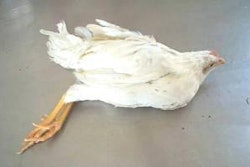The entire U.S. egg industry has been dominated by the fallout from the extensive egg recall associated with the DeCoster-owned Wright County Egg Complex and the associated operation of Hillandale Farms of Iowa.
The commentary “The SE recall: Inevitable or accidental?” outlined the facts as known and raised questions which must be answered if the industry is to aggressively respond to maintain consumer confidence, support the UB price, which has crashed and prevented SE being the “new cholesterol” of the current decade. As of the second week in September, there is no evidence that the outbreak involved other than the index farm although nearly 1,500 individual cases of SE involving numerous localized outbreaks have been documented.
Tracking points out risks
Given the resources of the CDC in detection and recognition of outbreaks, it must be appreciated that the combined resources of FoodNet and PulseNet are capable of ascertaining the presence of an infection and establishing relationships between patients and their source of infection.
The fact that the recall involved many states and numerous packing plants highlights the risks associated with large-scale trading of nest-run eggs, which are purchased without certification that flocks of origin are certified free of SE and with no concern for the operating standards applied by producers of lower-cost trade eggs.
Misinterpretation by the media
The published 483 documents from the FDA have been subjected to amplification, misinterpretation and sensationalism by the media. Unfortunately, the impression has been created that the obviously suboptimal conditions on the affected farms reflect procedures, housing and management which are not representative of the industry as a whole.
The FDA website states, “Our investigators are trained to ensure that each observation noted on the 483 is clear, specific and significant.” The website adds “the observations are cited when in an investigator’s judgment these conditions as observed indicate that a FDA-regulated product is in violation of FDA requirements.” This approach is valid for a food processing or pharmaceutical plant. There are profound questions as to the training of investigators and their subjective interpretation of findings.
Lack of communication
It is a matter of fact that the FDA has not communicated with other federal agencies including USDA-APHIS, with university personnel, avian disease specialists or Veterinarians trained in epidemiology and food safety relating to eggs. This is denoted by the fact that the guidance document relating to the Final Rule was incomplete and had not been issued at the time that the directives came into effect on July 1.
The FDA either ignored or rejected the principle of vaccination, widely regarded as an important component to any SE prevention program. The FDA failed to appreciate the logistic problems associated with routine microbiological procedures for surveillance of flocks. They failed to harmonize their laboratory requirements with those of the NPIP and were apparently oblivious to the advantages of PCR technology.
Multiple deficiencies found at infected facilities
Notwithstanding the level of competence of FDA inspectors, it is evident from the reports of alleged deficiencies, which were noted at the Wright County Egg Division of Quality Egg LLC and the affiliated DeCoster feed mill, that these facilities functioned at a level which promoted both the introduction and dissemination of SE.
The deficiencies which were apparently documented related to failure to control rodents, incorrect manure management to the point of slurries and accumulation of material displacing doors at the ends of houses, neglect of fly control, allowing wild birds to enter feed the mill and layer houses and failure to implement an appropriate SE monitoring program.
Unfortunately, FDA inspectors apparently regard movement of personnel and failure to compartmentalize houses in an in-line unit as a deficiency in biosecurity. There is little point in requiring a change in clothing for workers and managers moving through houses on a complex since mice will migrate between houses especially after depletion of a flock Air-extraction rates my exceed 500,000 cfm and egg collecting belts and conveyors move product along internal corridors passing the front of egg elevators.
A number of industry professionals have noted that there is limited to no inter-house biosecurity on a complex with up to 12 separately housed flocks. This commentator has always maintained that there are only SE-negative and SE-positive complexes. The concept of a negative house on a positive complex is a function of low sensitivity of environmental drag swabbing.
The adoption of the UEP’s self-serving 5-Star Total Quality Assurance Food Safety Program of monitoring flocks only two weeks before depletion meant that producers on finding an environmental positive could ignore the finding until adjacent houses were depleted ignoring the possibility of lateral extension to adjacent units. In cases where I have been involved in investigating SE “breaks”, neighboring houses are frequently shown to be infected by environmental swabbing of manure, fan blades and louvers or assaying the gastrointestinal tracts of trapped mice.
Questions remain
A number of significant questions have yet to be addressed in the epidemiologic investigation of practices and events on the affected farms. Most of these relate to biosecurity, immunization, rodent control, maintenance of facilities, training of management, and commitment of the owners to programs which would unfortunately perpetuate SE infection.
It is obviously advantageous to detect contamination in an egg production facility before a recall results in infection of consumers. Had the industry adopted an effective program such as the Pennsylvania or California EQAPs or the procedures mandated by the franchiser of a national brand of specialty eggs, we would not be faced with the current level of concern among food marketing chains, the food service industry and consumers.
Since the legal implications and cost associated with persistent SE infection will be unacceptable in the future, the industry will have to adopt a new attitude towards food safety and specifically suppression of SE.
Measures such as enhanced biosecurity, vaccination, rodent control, exclusion of rodents through structural modifications, appropriate manure handling in high-rise houses and realistic and frequent monitoring will add to the cost of our product. Expenditure will be critical to survival going forward into the current decade.
Industry must overcome recall with grace
As noted in the commentary, our industry will be impacted by the outbreak and recall. We are all on notice that further episodes will result in additional negative publicity and demands for greater legislative control over our production practices. We must also appreciate that the negative publicity arising from the recall has provided ammunition to opponents of intensive egg production and it is difficult to now differentiate between food safety and flock welfare.
There will obviously be an increase in demand for pasteurized egg products especially for the institutional and food service markets. The trend in the reduction in breaking will be reversed in coming years. This may in fact represent an advantage for the industry as consumer demand will favor further-processed and convenienced egg-based items which will enhance margins compared to commodity shell eggs.
The egg industry will have to be purer than Caesar’s wife as it is evident that the FDA will continue to make capital of the DeCoster debacle since the agency is under extreme pressure and faces transfer of its authority over food to a new food safety agency. Managers at the FDA will exert their authority to the maximum to justify their existence and to demonstrate that they are aggressively responding to a food borne disease.
As an industry, we must demonstrate that individually and collectively we are pursuing programs which provide a nutritious and safe product to our consumers. Defending companies and individuals who deviate from acceptable standards is counterproductive. We look to our industry organizations including the AEB, USPOULTRY and UEP for positive leadership to develop programs which encourages adoption of effective measure to suppress and ultimately eliminate SE from our flocks.
Opposing the FDA and other federal agencies will not prove to be productive. Failure to disassociate substandard operations by imposing expulsion will be detrimental to future acceptance of our product.
Adopting accepted principles of crisis management and response and avoiding the blame-the-victim game will all be required to reverse the adverse publicity which has been imposed on us by the actions of a single large producer. Indirectly, the companies that purchase and re-pack “cheap eggs” under their own brands and plant numbers without regard to quality or safety bear a proportionate share of the blame for the current episode.


















